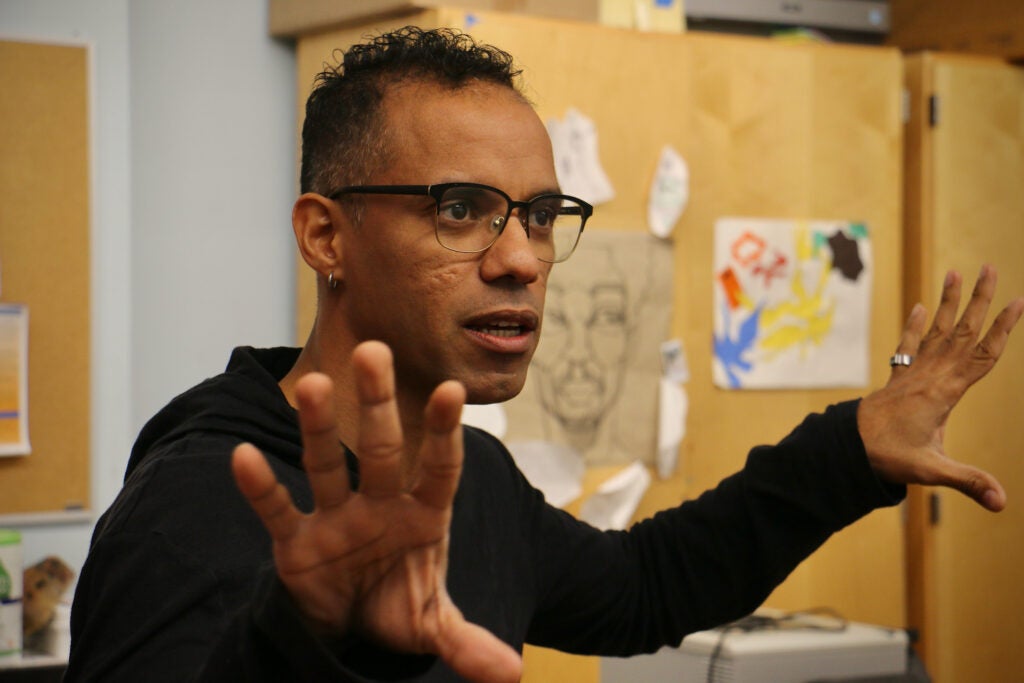This story is a part of the Every Voice, Every Vote series.
From Philly and the Pa. suburbs to South Jersey and Delaware, what would you like WHYY News to cover? Let us know!
In his third-floor walk-up office at Mural Arts Philadelphia, Emilio Maldonado has been compiling a spreadsheet of professional opportunities for artists in the city. He spends his time tracking listings, blogs, and announcements for job opportunities, residencies, grants, and requests for proposals.
“It’s always a chase,” he said.

When Maldonado started working as director of artist relations for Mural Arts, finding resources was easy. That was in 2020, when the pandemic and the social unrest of that year triggered a lot of rescue funds and support, particularly for artists of color.
“There were a lot of initiatives that came as a response to 2020. There are not anymore,” he said. “They’re all defunct. That was a clearing act.”
Mural Arts is the largest employer of visual artists in the city, hiring 250-300 artists every year for its various public art projects. Because Maldonado is able to connect artists to professional resources, including public art projects outside of Mural Arts, he is often approached by artists looking for work.
They also want advice.
“I’ve had artists that say: ‘How can I get an assistant job, working as an artist’s assistant?’ ‘Should I go for a masters?’” he said. “For some people it’s, like, ‘What do you think about my website?’”
Mural Arts plans to launch a webpage, likely in January, that posts professional development resources available to artists for free, updated constantly.
“Mural Arts wouldn’t exist without the artists. As plain as that,” said MAP’s senior director of learning and practice, Netanel Portier. “If we want the work that we’re supporting and doing collaboratively with artists to continue, we need to support those artists.”
Mural Arts has a specific niche in the art world: public art, most often as murals painted on walls. Portier would like to partner with other organizations to coordinate artist development resources across the wider creative sector, including the Office of Arts, Culture, and the Creative Economy (OACCE) in City Hall.
“I have seen in the past years that they have really been making an effort to create more opportunities for artists in the city,” she said.
The two candidates for Philadelphia’s next mayor, David Oh and Cherelle Parker, have both said during their campaigns they would establish a permanent, cabinet-level department of arts and culture.
The Greater Philadelphia Cultural Alliance is urging the next mayor to establish an art department that is able to integrate art across all other city departments, involving artists in things like commerce, health and human services, and public safety. In its policy platform, the GPCA is also demanding the next mayor prioritize creative capital so artists can more easily live and work in the city.
Some of that work is currently being done inside the OACCE. A year ago, the city’s Director of Public Art, Marguerite Anglin, began hosting a regular webinar, “Public Art, How to Start?” in which she introduces artists to the process of conceiving, presenting, and budgeting a public art proposal.
“We realized there was a need to demystify the public art process, especially for artists in Philadelphia,” Anglin said. “They don’t know what it takes to compete for a public art opportunity. They don’t even know what a public art project involves, or how to start. There’s this issue of underrepresentation of local and diverse artists.”
Most of the OACCE’s public art projects come from the Philadelphia’s One Percent for Art program, which require city capital projects and some private developers to spend 1% of construction costs on public art. Anglin said at any given time she has about 16-20 active pubic art projects on the ground.
Familiarizing more artists with the process of creating public work can enlarge the pipeline of available talent. When the city considers an art project proposal, the selection committee takes into account the artist’s connection with the community in which the project will be made. But Anglin said a pool of submitting artists often have little to no direct connection.
“Maybe it’s a very small number, or smaller than what we would have hoped,” said Anglin. “But we’re also looking for artists that reflect diversity. Are they representative of that community? And also, what type of community engagement approach are they suggesting?”
If the next mayor establishes a permanent arts and culture department, it could stabilize City Hall’s efforts in the arts sector. Over the years, the OACCE’s budget has fluctuated, and its operation has been moved from one City Hall office to another. Since 2020, it has operated in the office of the managing director.
“We’ve been in so many different kinds of budget line items,” Anglin said. “Having a stable department would definitely show the importance of arts and culture in our city and would allow the department to project and plan out in advance a budget and how we grow our programs.”